#trauma and recovery
Text
There are a lot of things I'm sad about in my life. You don't get to go through the kind of medical trauma I've been through and come out unscathed on the other side.
But one thing I'm really bitter about is that I can't remember my wedding anymore. The pernicious anemia took it from me and wiped my brain clean. Except it's not clean, not really. I remember it in patches. Like red wine stains on a white rug that have never quite lifted out no matter how hard you try.
I look at the pictures on my bookcase, and they feel like remembering a story someone else has told me. There's a young woman in a white dress wearing my face, and she looks happy. I'm happy for her. But you can see the strain around her eyes, too. The pain she's hiding because no one with authority believes her when she says her body doesn't feel right. That something is Wrong.
They won't believe her for another decade. They won't believe her until it's almost too late, and it's that lateness that will rob her of her memories and turn them into a wavering rainbow suspended in the fine haze of watery sunlight that occasionally surfaces through the blanks.
There's one memory that's real, though. Solid. It's not my vows. It's not my father walking me down the aisle. (Though those are there, just hazy and dream-like). It's our first dance.
It's the lights dimming around the room as the staff cleared the floor, causing the fishbowls full of white roses and LED lights on the tables to wobble like pools of moonlight against dark paneled walls.
It's the band inviting us out onto the floor and us giggling because we know what's coming next, and no one else does. It's the twang of a banjo reverberating around the room through the speakers, followed by the dulcet tones of Kermit the Frog wondering why there are so many songs about rainbows.
It's us waltzing around the enclosed circle of light, singing to each other out of tune and grinning like idiots as everyone around us starts to laugh.
It's everyone joining in on the song because it's the Muppets, and everyone knows the words. It's 100+ people singing the Rainbow Connection, some laughing, some a bit tearful, because it's bringing back memories. Because it's making a new one.
It's looking up at my new husband through the brain fog and all the pain in my body and thinking, "I want to remember this moment forever."
I don't know what entity was out there listening to me at that moment and chose to grant that wish. I don't know why this is the one memory that stuck while everything else in my brain got decimated into scattered, fragmented snapshots. But I'm so, so thankful it is.
Though, I could have done without it randomly coming on my YouTube music out of nowhere to hit me in the emotions like a brick to the back of the head. Jesus Christ.
6K notes
·
View notes
Text
“What Freud heard was appalling. Repeatedly, his patients told him of sexual assault, abuse, and incest. Following back the thread of memory, Freud and his patients uncovered major traumatic events of childhood concealed beneath the more recent, often relatively trivial experiences that had actually triggered the onset of hysterical symptoms. By 1896, Freud believed he had found the source. In a report on eighteen case studies, entitled The Aetiology of Hysteria, he made a dramatic claim: “I therefore put forward the thesis that at the bottom of every case of hysteria there are one or more occurrences of premature sexual experience, occurrences which belong to the earliest years of childhood, but which can be reproduced through the work of psycho-analysis in spite of the intervening decades. I believe that this is an important finding, the discovery of a caput Nili in neuropathology.”
Its triumphant title and exultant tone suggest that Freud viewed his contribution as the crowning achievement in the field. Instead, the publication of The Aetiology of Hysteria marked the end of this line of inquiry. Within a year, Freud had privately repudiated the traumatic theory of the origins of hysteria. His correspondence makes clear that he was increasingly troubled by the radical social implications of his hypothesis. Hysteria was so common among women that if his patients’ stories were true, and if his theory were correct, he would be forced to conclude that what he called “perverted acts against children” were endemic, not only among the proletariat of Paris, where he had first studied hysteria, but also among the respectable bourgeois families of Vienna, where he had established his practice.
This idea was simply unacceptable. It was beyond credibility. Faced with this dilemma, Freud stopped listening to his female patients.
The turning point is documented in the famous case of Dora. This, the last of Freud’s case studies on hysteria, reads more like a battle of wits than a cooperative venture. The interaction between Freud and Dora has been described as “emotional combat.” In this case Freud still acknowledged the reality of his patient’s experience: the adolescent Dora was being used as a pawn in her father’s elaborate sex intrigues. Her father had essentially offered her to his friends as a sexual toy. Freud refused, however, to validate Dora’s feelings of outrage and humiliation. Instead, he insisted upon exploring her feelings of erotic excitement, as if the exploitative situation were a fulfillment of her desire. In an act that Freud viewed as revenge, Dora broke off the treatment. The breach of their alliance marked the bitter end of an era of collaboration between ambitious investigators and hysterical patients. For close to a century, these patients would again be scorned and silenced. Freud’s followers held a particular grudge against the rebellious Dora, who was later described by a disciple as “one of the most repulsive hysterics” he had ever met.
Over time, Freud’s repudiation of the traumatic theory of hysteria did take on a peculiarly dogmatic quality. The man who had pursued the investigation the furthest and grasped its implications the most completely retreated in later life into the most rigid denial. In the process, he disavowed his female patients. Though he continued to focus on his patients’ sexual lives, he no longer acknowledged the exploitative nature of women’s real experiences. With a stubborn persistence that drove him into ever greater convolutions of theory, he insisted that women imagined and longed for the abusive sexual encounters of which they complained. He went on to develop a theory of human development in which the inferiority and mendacity of women are fundamental points of doctrine. In an antifeminist political climate, this theory prospered and thrived.”
- Trauma and Recovery by Judith Herman
1K notes
·
View notes
Text
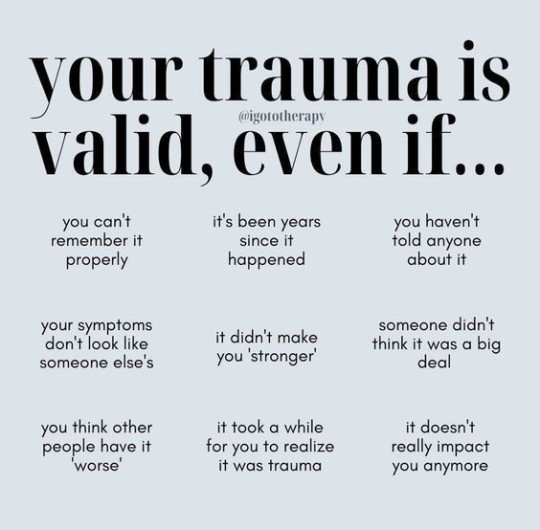
#mental health#positive mental attitude#mental wellbeing#mental wellness#positivity#self healing#therapy#mental illness#trauma#trauma recovery#trauma healing#trauma and recovery#trauma awareness#trauma brain#trauma coping#trauma disorders#post traumatic stress disorder#just cptsd things#cptsd recovery#living with cptsd#cptsd problems#ptsd#complex ptsd
144 notes
·
View notes
Text
Mother, as in: the first person I loved. The first person to break my heart. The wound that never stops bleeding. The wound. Oh, god, the wound. It's been twenty years, how is it still bleeding?
Mother, I know I was born from your blood. But when will I have bled enough to make up for it?
#spilled ink#poetry#prose#writing#spilled heart#spilled thoughts#excerpt#trauma and recovery#heartache#mother wound#quotes
51 notes
·
View notes
Text
“Survivors who self-mutilate consistently describe a profound dissociative state preceding the act. Depersonalization, derealization, and anesthesia are accompanied by a feeling of unbearable agitation and a compulsion to attack the body. The initial injuries often produce no pain at all. The mutilation continues until it produces a powerful feeling of calm and relief; physical pain is much preferable to the emotional pain that it replaces. As one survivor explains: 'I do it to prove I exist.'”
Trauma and Recovery, Judith Herman
#tw self harm#tw self h@rm#trauma and recovery#judith herman#self h@rm#self mutilation#cutt1ng#childhood trauma#trauma#childhood abuse#dissociation#derealization#depersonalization
47 notes
·
View notes
Text
Reading Judith Herman's Trauma and Recovery now, and it still contains triggering content including some disturbing details around CSA cases, but the feminist perspective is fantastic and it's putting words to the question of why the fuck we keep letting abusers off the hook. From chapter 1:
To study psychological trauma means bearing witness to horrible events. When the events are natural disasters or "acts of God," those who bear witness sympathize readily with the victim. But when the traumatic events are of human design, those who bear witness are caught in the conflict between victim and perpetrator. It is morally impossible to remain neutral in this conflict. The bystander is forced to take sides.
It is very tempting to take the side of the perpetrator. All the perpetrator asks is that the bystander do nothing. He appeals to the universal desire to see, hear, and speak no evil. The victim, on the contrary, asks the bystander to share the burden of pain. The victim demands action, engagement, and remembering.
I don't know how to stop this cycle, but if you can know, name, and keep in mind the temptation, only then can you resist it. Remember these words and take the hard path.
174 notes
·
View notes
Text

“The core experiences of psychological trauma are disempowerment and disconnection from others. Recovery, therefore, is based upon the empowerment of the survivor and the creation of new connections. Recovery can take place only within the context of relationships; it cannot occur in isolation. In her renewed connections with other people, the survivor re-creates the psychological faculties that were damaged or deformed by the traumatic experience. These faculties include the basic capacities for trust, autonomy, initiative, competence, identity, and intimacy. Just as these capabilities are originally formed in relationships with other people, they must be reformed in such relationships.”
— Trauma and Recovery, Judith Herman
[alive on all channels]
#relationship#recovery#trauma#psychological trauma#disempowerment#disconnection#Trauma and Recovery#Judith Herman#alive on all channels
20 notes
·
View notes
Text
I don’t know who needs to hear this but it’s okay if you’re not over it!! It’s okay to still be grieving, it’s okay to still be angry, it’s okay to still be sad, emotions are important and are meant to be felt! It doesn’t matter how long it’s been, the process of moving on is long and non-linear and different for everyone! I know society tends to push this idea that there’s only acceptable amount of time to be upset about the past before people think it’s weird, but please don’t let that make you feel ashamed! Take your time to feel how you feel. Don’t feel pressured to forgive others who harmed you if you don’t want to either, it’s not necessary for you get over it! But please, do try to forgive yourself. 💕
#reminders#self care reminder#trauma#trauma posting#mental heath support#mental heath awareness#mental wellbeing#actually mentally ill#trauma awareness#trauma healing#trauma and recovery#traumatic event#actually traumatized#mental wellness#healing#self healing#self care#self compassion#greiving#grief#dealing with grief#coping with grief#grief journey
15 notes
·
View notes
Text
One of the hardest things to get over about being abused is that so often your abuser(s) doesn't think they did anything wrong.
28 notes
·
View notes
Text
My friends, siblings, acquaintances, & fellow travelers: never let the thought "I feel happy;is there something wrong?" cloud your head if you can help it, and if you can't, like I sometimes can't for myself, maybe try to remember that I'm happy that you're happy and I don't see a single thing wrong with you, and I have people who think the same thing of me, so I know a little bit of what I'm talking about. I love you 🥖🌹
93 notes
·
View notes
Text
“We know that the women who recover most successfully are those who discover some meaning in their experience that transcends the limits of personal tragedy. Most commonly, women find this meaning by joining with others in social action. In their follow-up study of rape survivors, Burgess and Holmstrom discovered that the women who had made the best recoveries were those who had become active in the anti-rape movement. They became volunteer counselors at rape crisis centers, victim advocates in court, lobbyists for legislative reform. One woman traveled to another country to speak on rape and organize a rape crisis center. In refusing to hide or be silenced, in insisting that rape is a public matter, and in demanding social change, survivors create their own living monument. In the task of healing, therefore, each survivor must find her own way to restore her sense of connection with the wider community.”
- Trauma and Recovery by Judith Herman
270 notes
·
View notes
Text
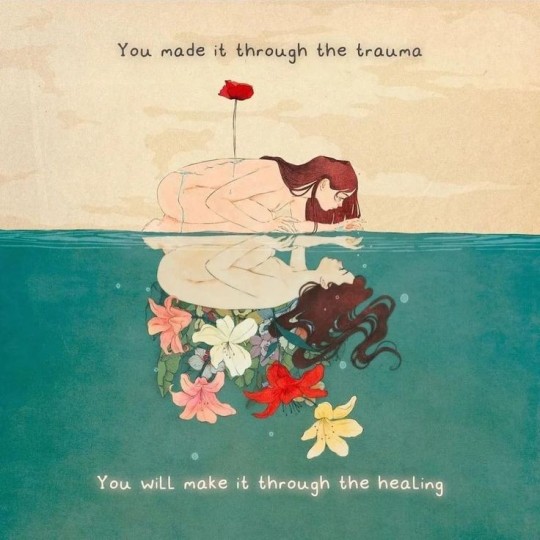
#trauma recovery#trauma related#trauma and recovery#post traumatic stress disorder#trauma#actually ptsd#complex ptsd#just cptsd things#living with cptsd#cptsd recovery#recovery#mental health#positive mental attitude#mental wellbeing#mental wellness#self healing#mental illness
24 notes
·
View notes
Text
Prolonged captivity also produces profound alterations in the victim’s identity. All the psychological structures of the self—the image of the body, the internalized images of others, and the values and ideals that lend a person a sense of coherence and purpose—have been invaded and systematically broken down. In many totalitarian systems this dehumanizing process is carried to the extent of taking away the victim’s name. [Jacobo] Timerman calls himself a “prisoner without a name.” In concentration camps the captive’s name is replaced with a nonhuman designation, a number. In political or religious cults and in organized sexual exploitation, the victim is often given a new name to signify the total obliteration of her previous identity and her submission to the new order. Thus Patricia Hearst was rebaptized Tania, the revolutionary; Linda Boreman was renamed Linda Lovelace, the whore.
Even after release from captivity, the victim cannot assume her former identity. Whatever new identity she develops in freedom must include the memory of her enslaved self. Her image of her body must include a body that can be controlled and violated. Her image of herself in relation to others must include a person who can lose and be lost to others. And her moral ideals must coexist with knowledge of the capacity for evil, both within others and within herself. If, under duress, she has betrayed her own principles or has sacrificed other people, she now has to live with the image of herself as an accomplice of the perpetrator, a “broken” person. The result, for most victims, is a contaminated identity. Victims may be preoccupied with shame, self-loathing, and a sense of failure.
In the most severe cases, the victim retains the dehumanized identity of a captive who has been reduced to the level of elemental survival: the robot, animal, or vegetable. The psychiatrist William Niederland, in studies of survivors of the Nazi Holocaust, observed that alterations of personal identity were a constant feature of the “survivor syndrome.” While the majority of his patients complained, “I am now a different person,” the most severely harmed stated simply, “I am not a person.”
— Judith L. Herman, Trauma and Recovery: The Aftermath of Violence - from Domestic Abuse to Political Terror
#well!#i should've reread this book sooner#reading journal#trauma and recovery#judith herman#i'm aware linda lovelace's situation is a thorny subject and herman's attitude towards it is really trenchant
15 notes
·
View notes
Text
“Feelings of rage and murderous revenge fantasies are normal responses to abusive treatment. Like abused adults, abused children are often rageful and sometimes aggressive. They often lack verbal and social skills for resolving conflict, and they approach problems with the expectation of hostile attack. The abused child’s predictable difficulties in modulating anger further strengthen her conviction of inner badness. Each hostile encounter convinces her that she is indeed a hateful person.”
Trauma and Recovery, Judith Herman
#trauma and recovery#judith herman#homicidal ideation#childhood trauma#trauma#childhood abuse#trauma response
15 notes
·
View notes
Text
"In Trauma and Recovery, Herman expresses the additional concern that patients with CPTSD frequently risk being misunderstood as inherently 'dependent', 'masochistic', or 'self-defeating' [personality disorders], comparing this attitude to the historical misdiagnosis of female hysteria."
~ Wikipedia's CPTSD article

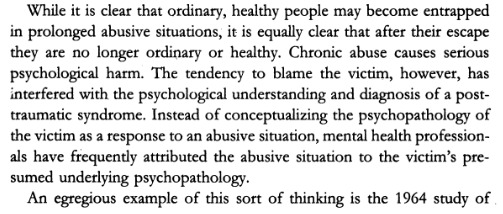
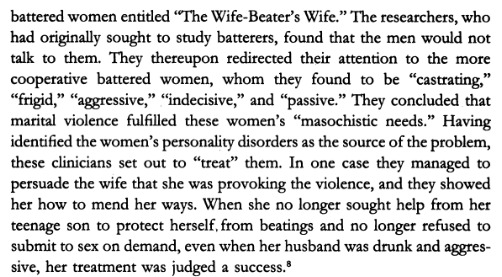

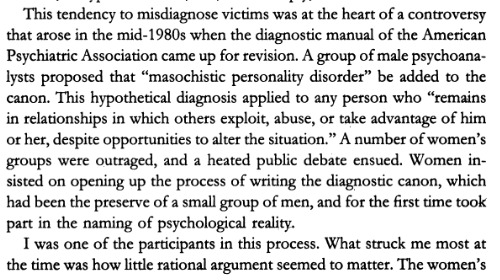

~ Judith Herman, Trauma and Recovery (2015), pp. 116-118.
Thank you to @/avoydant, who transcribed these images. The transcriptions have been added to the alt text.
#so many pds could just be subtypes of cptsd. maybe even all of them.#cptsd#pd info#judith herman#trauma and recovery#dpd#dpd info#masochistic personality disorder#self defeating personality disorder#hysteria#pds and trauma#dogpost#hpd#hpd info#passive aggressive personality disorder#negativistic personality disorder#sexism and misogyny in psychiatry#victim blaming#abuse tw#psych critical#anti psych#anti psychiatry#psychiatry critical#described#described in alt text#i was gonna just post a snippet of the section but the whole thing is important
52 notes
·
View notes
Text

I was not prepared for how hard this hit me.
#trauma and recovery#post traumatic stress disorder#trauma#traumatic childhood#childhood trauma#trauma and abuse#abusive parents#child abuse#emotional abuse#psychological abuse#mental abuse#abuse#abusive childhood
9 notes
·
View notes